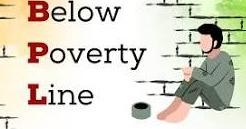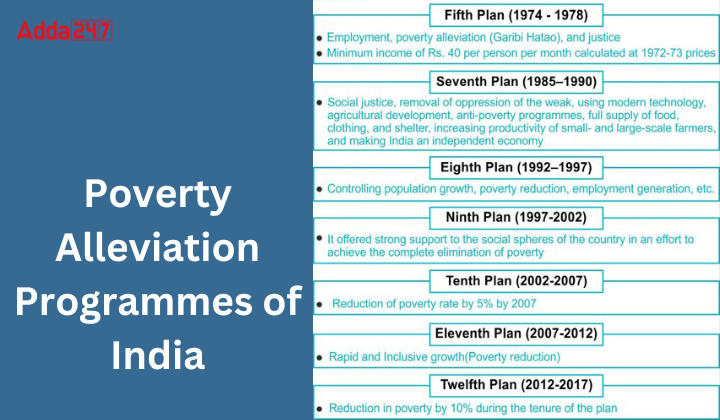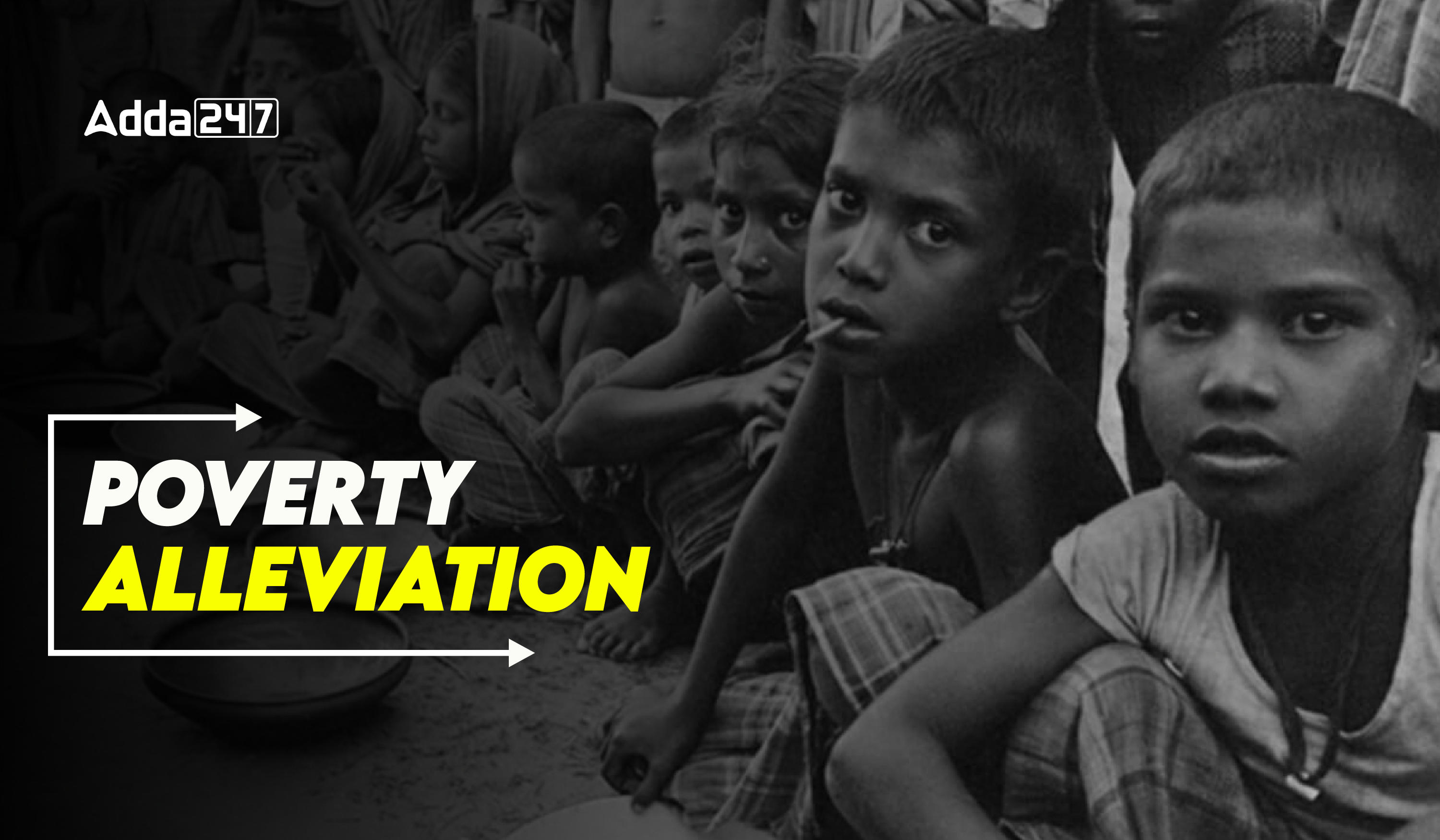Table of Contents
Poverty alleviation involves lifting people out of poverty, which has numerous positive societal impacts. Government-initiated programs aim to assist the underprivileged by focusing on specific industries to enhance their participation in economic growth and by strengthening social sector programs tailored for vulnerable groups. Understanding poverty alleviation programs is crucial for the UPSC IAS exam, covering a significant portion of the General Studies Paper-2 Syllabus, with a focus on those launched by the Indian government, including recent initiatives.
Poverty Alleviation
Poverty Alleviation encompasses a series of economic and humanitarian measures aimed at eradicating poverty within a nation. In India, Poverty Alleviation Programs are designed to reduce poverty rates by providing households and families below the poverty line with access to food, financial aid, and essential resources.
According to the World Bank, severe poverty, affecting 767 million people worldwide, is defined as living on $1.90 or less per day. Data from the Asian Development Bank reveals that in 2011, 21.9 percent of Indians were living in poverty. The Indian government has established numerous initiatives and programs to combat poverty and meet the basic needs of disadvantaged households.
Below Poverty Line (BPL)
The Below Poverty Line (BPL) serves as an economic criterion for identifying financially disadvantaged individuals and households. Set by the Government of India, BPL is determined based on a specified income threshold. Individuals or households earning below this threshold are categorized as being below the poverty line.

Measuring BPL in India
BPL measurement in India hinges on per capita income rather than price levels. It represents the minimum income necessary to afford essential goods and services to meet basic human needs. The proportion of the population falling below this line is termed the poverty ratio or headcount ratio, a method commonly employed by countries and international organizations.
In India, the first official rural and urban poverty lines were established nationally in 1979 by the Y. K. Alagh Committee, each with distinct criteria. Presently, the level of deprivation is evaluated using a scoring system ranging from 0 to 4, based on 13 parameters, as per the Tenth Five-Year Plan.
Families scoring 17 marks or less out of a maximum of 52 are classified as BPL, previously 15 marks or less. The poverty line is recalculated every five years. As per recent estimations considering inflation, the threshold income stands at over Rs. 962 per month for urban areas and Rs. 768 per month for rural areas, translating to above Rs. 32 per day in urban areas and above Rs. 26 per day in rural areas.
Poverty Alleviation in India – Five-Year Plans
India initiated Eleven Five-Year Plans in its endeavor to eradicate poverty. Here is a brief overview of each:
- First Five-Year Plan (1951-1956): Emphasized agriculture, irrigation, and balanced development.
- Second Five-Year Plan (1956-1961): Focused on basic and heavy industries, employment growth, and a 25% increase in national income.
- Third Five-Year Plan (1961-1966): Hampered by conflicts and drought, leading to failure and replaced by three annual plans.
- Fourth Five-Year Plan (1966-1974): Aiming at 5.5% national income growth, economic stability, and social justice.
- Fifth Five-Year Plan (1974-1979): Focused on poverty alleviation (Garibi Hatao) and raising masses above poverty line.
- Sixth Five-Year Plan (1980-1985): Emphasized poverty removal, economic growth, unemployment elimination, and technology self-sufficiency.
- Seventh Five-Year Plan (1985-1990): Targeted poverty reduction and improved living standards.
- Eighth Five-Year Plan (1992-1997): Aimed at employment generation but faced challenges in meeting targets.
- Ninth Five-Year Plan (1997-2002): Focused on agriculture, employment, poverty, and infrastructure.
- Tenth Five-Year Plan (2002-2007): Aiming to reduce poverty ratio to 21% and ensure five years of schooling for children.
- Eleventh Five-Year Plan (2007-2012): Targeted reducing poverty by 10%, generating 7 crore new jobs, and providing electricity to all villages.
Poverty Alleviation Programmes of India
Since the early 1950s, the Indian government has initiated, sustained, and enhanced various planning programs aimed at enabling the underprivileged to attain self-sufficiency in acquiring food and overcoming hunger and poverty. These efforts were particularly evident in the successive five-year plans (FYP), with explicit measures aimed at poverty alleviation being incorporated into each of them.

List of Poverty Alleviation Programmes in India
The Indian government initiated several Poverty Alleviation Programs in the country. Here are some of them listed in the table below:
| Schemes | Objectives |
| The Integrated Rural Development Programme (IRDP) |
|
| Jawahar Rozgar Yojana/Jawahar Gram Samridhi Yojana (JRY) |
|
| Indira Awaas Yojana for Rural Housing |
|
| Food for Work Program |
|
| National Old Age Pension Scheme |
|
| Sampoorna Gramin Rozgar Yojana |
|
| Mahatma Gandhi National Rural Employment Guarantee Act of 2005 (MGNREGA) |
|
| Aajeevika (2011) |
|
| The National Urban Livelihood Mission (NULM) |
|
| Pradhan Mantri Kaushal Vikas Yojana |
|
| Pradhan Mantri Jan Dhan Yojana |
|
| National Food Security Act (NFSA) |
|
| Gram Swaraj Abhiyan (GSA) |
|
| Pradhan Mantri Adarsh Gram Yojana (PMAGY) |
|
| Sansad Adarsh Gram Yojana (SAGY) |
|
| NITI Aayog’s Task Force on Poverty Elimination |
|
| National Social Assistance Programme |
|
Public Distribution System Role in Poverty Alleviation
The Public Distribution System (PDS) serves as a crucial mechanism for managing and distributing food grains, playing a significant role in poverty alleviation in India. Operated jointly by the Central and State Governments, its responsibilities include allocating essential commodities like rice, wheat, kerosene, and sugar, issuing ration cards for those below the poverty line, identifying impoverished families, and managing food scarcity and distribution.
In June 1997, PDS was revamped as the Targeted Public Distribution System (TPDS), overseen by the Ministry of Consumer Affairs, Government of India. TPDS emphasizes identifying and assisting the poor in accessing food grains effectively, thus enhancing the poverty alleviation efforts.
Impact of Poverty Alleviation Programmes in India
- The percentage of absolute poverty has decreased below the national average due to successful Poverty Alleviation Programs’ assessments in various states.
- Despite poverty reduction efforts, issues like hunger, undernourishment, illiteracy, and lack of basic necessities persist in many Indian regions.
- Over the past 55 years, the approach to poverty reduction has evolved gradually but hasn’t resulted in significant change.
- Possible changes in program names, integration, or mutations haven’t led to a fundamental shift in asset ownership, production methods, or provision of basic necessities to the poor.



 TSPSC Group 1 Question Paper 2024, Downl...
TSPSC Group 1 Question Paper 2024, Downl...
 TSPSC Group 1 Answer key 2024 Out, Downl...
TSPSC Group 1 Answer key 2024 Out, Downl...
 UPSC Prelims 2024 Question Paper, Downlo...
UPSC Prelims 2024 Question Paper, Downlo...
